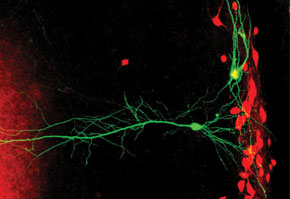
Richardson Leão / UFRNOLM interneuron (green) links cells from the outermost layer of the hippocampus to those of the innermost layerRichardson Leão / UFRN
It took almost a century to discover the function of a special type of brain cell described by Spanish physician and neuroanatomist Santiago Ramón y Cajal. These cells, which have the complicated name of oriens-lacunosum moleculare (OLM) interneurons, are located in the hippocampus, a deep brain structure associated with memory acquisition. Like a bridge linking two riverbanks, OLM interneurons make contact between the cells in the outermost layer of the hippocampus and the cells in deeper areas. But the precise role of these cells had always been elusive.
Now, in an article published in the October 7, 2012, issue of Nature Neuroscience, neuroscientist and Minas Gerais native Richardson Leão, along with researchers from the United States and Sweden, have shown that OLM interneurons are a type of gatekeeper of memory.
“We managed to isolate and manipulate this population of interneurons,” says Richardson, a researcher at the Brain Institute of the Federal University of Rio Grande do Norte (UFRN). Using molecular biology techniques, he and researchers from Uppsala University in Sweden identified a protein that is produced exclusively by this type of neuron. They then developed transgenic mice in which they marked that protein with a red fluorescent one. They also inserted a third protein into the transgenic animal, which activates the neuron when a laser pulse is applied.
In their experiments they found that once OLM interneurons were activated, they blocked the arrival of sensory information from the environment to the hippocampus and activated chemical mechanisms that retrieve information stored in the brain. An example will make this clearer. When you’re walking down the street and see someone you know, the information captured by your eyes reaches the outermost layer of the hippocampus. This is when OLM interneurons go to work. They transfer the information to the deeper area, where the interneurons activate the memory retrieval mechanism – which, for instance, lets you remember who the fellow on the street is – but block the arrival of further data from the environment. “OLM interneurons turn off one circuit and turn on another,” says Richardson, who also collaborated with researchers from the University of Connecticut in the United States.
Scientific article
LEÃO, R. N. et al. OLM interneurons differentially modulate CA3 and entorhinal inputs to hippocampal CA1 neurons. Nature Neuroscience. 7 Oct. 2012.